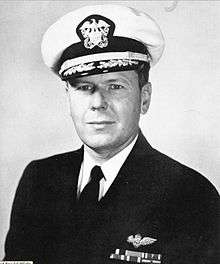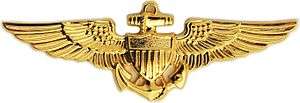Evan Peter Aurand
| Evan Peter Aurand | |
|---|---|
 | |
| Nickname(s) | "Pete" |
| Born |
June 10, 1917 New York City |
| Died |
June 7, 1989 (aged 71) Honolulu, Hawaii |
| Allegiance |
|
| Service/branch |
|
| Years of service | 1938–1972 |
| Rank |
|
| Commands held |
Antisubmarine Warfare Force Pacific USS Independence USS Greenwich Bay |
| Battles/wars |
World War II Cold War Vietnam War |
| Awards |
Navy Cross Navy Distinguished Service Medal Legion of Merit (3) |
Evan Peter Aurand (June 10, 1917 - June 7, 1989) was a decorated naval officer with the rank of Vice Admiral. He was a son of Lieutenant general Henry Aurand.
Biography
Evan Peter Aurand was born in New York City on June 10, 1917. He was the son of Margaret Decker, a great-granddaughter of Texas leader Sam Houston, and U.S. Army officer Henry S. Aurand. A 1938 graduate of the United States Naval Academy, his long and fruitful navy career evinced a lifelong devotion to naval aviation and to his country. His flight experience spanned the development of modern aircraft. He trained at Pensacola in 1940 in the F4B-4 and qualified to fly the S-2E before he retired.
World War II
During World War II, he served in combat service in the Pacific Theater, which earned him the Navy Cross, a Legion of Merit medal, a Navy Commendation Medal, the Air Medal, two Distinguished Flying Crosses and a Presidential Unit Citation aboard the USS Bunker Hill,[1] he was part of Project Afirm, based at Quonset Point Naval Air Station, which, at great peril to the pilots involved, pioneered radar-guided flight and thus, night-fighting capability for the U.S. fleet.[2] For that service, he was decorated with the Legion of Merit and another Navy Commendation Medal.
Military career
Postwar, he was commanding officer of VF-5A, based at North Island NAS, the first West Coast Navy squadron to employ jet aircraft. In this capacity, he made the first carrier arrested landing by a Naval Aviator piloting the jet aircraft FJ-1 Fury, on the deck of the USS Boxer in March, 1948. He participated in various air races, setting speed records for many routes, bringing progress in Naval Aviation into the public eye.
Serious injuries from an automobile accident (on one of his many trips to meet with defense contractors to improve fighter plane design) kept him out of the Korean Conflict, during which he studied at the Air War College in Montgomery, Alabama.
He was then assigned to Air Weapons and Tactics, Staff, Commander Operational Development Force, Norfolk, VA.
He then served as Operations Officer and then Executive Officer of the USS Hancock, CVA 19. A serious amateur photographer and videographer, he conceived, filmed and produced the naval aviation spoof film "Launch 'Em" while aboard Hancock.
After a short stint at the Pentagon serving as Naval Aide to the Assistant Secretary of the Navy for Personnel and Reserve Forces, he was named Naval Aide to President Dwight D. Eisenhower in 1956, relieving Captain Edwin (“Ned”) Beach. His duties included running Camp David and the White House Mess. He got the President on or near the water, aboard Navy vessels and involved in Naval operations at every opportunity. He suggested and implemented the use of Marine helicopters for transporting the President on short and medium length trips, allowing the President to take off and land directly on the White House lawn for the first time. During this duty, a chance meeting with Captain William Anderson, skipper of the USS Nautilus, led to discussion of possibilities and a plan to have the Nautilus transit the North Pole under the polar ice cap. He was part of the Killian Committee. He was awarded a second Legion of Merit for his service as Naval Aide to the President.
His next sea duty was command of the seaplane tender USS Greenwich Bay, followed by command of the USS Independence, CVA 62. He then attended the Advanced Management Program at Harvard University.
While commanding Antisubmarine Warfare Group One in VietNam, he was awarded a third Legion of Merit for his idea for in-flight refueling of helicopters and other tactics for the seventh fleet. He retired as Commander, Antisubmarine Warfare Force Pacific (now Third Fleet) in 1972. In retirement, he defended Naval Aviation in letters to the editors of Honolulu papers whenever such were needed. He participated in many seminars at which he was invited to speak. He remained active in civic affairs in Honolulu until his death at 71 on June 7, 1989 and was buried at sea from the USS Benjamin Stoddert off Kawaihoa Point (Koko Head), Oahu.
Personal
He was preceded in death by his wife of 47 years, Patricia Riley of Mercer Island, Washington and three sons. He is survived by a daughter, Margaret L. H. Aurand, Esq. and two grandsons.
Decorations
 | |||
| Naval Aviator Badge | ||||
| 1st Row | Navy Cross | Navy Distinguished Service Medal | Legion of Merit with two Gold Stars | Distinguished Flying Cross with Gold Star |
|---|---|---|---|---|
| 2nd Row | Air Medal | Navy and Marine Corps Commendation Medal | Navy Presidential Unit Citation with one citation star | American Defense Service Medal |
| 3rd Row | American Campaign Medal | Asiatic-Pacific Campaign Medal with three Service Stars | World War II Victory Medal | National Defense Service Medal with Service Star |
Sources
Professional information taken from U.S. Navy records in possession of the subject.
| Wikimedia Commons has media related to Evan Peter Aurand. |